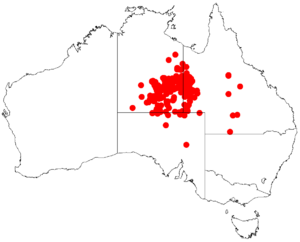Acacia georginae facts for kids
Quick facts for kids Acacia georginae |
|
|---|---|
 |
|
| Scientific classification | |
| Genus: |
Acacia
|
| Species: |
georginae
|
 |
|
| Occurrence data from AVH | |
| Synonyms | |
|
Racosperma georginae (Bailey) Pedley |
|
Acacia georginae is a tree that grows in dry areas of central Australia. It has also been brought to the United States. People often call it Georgina gidgee, Georgina gidyea, or poison gidyea. It's known for its seed pods, which can be very harmful to animals.
What it Looks Like
This tree usually grows to be about 3 to 8 meters (10 to 26 feet) tall. It has a thick top part with branches that are grey or white and a bit hairy.
Like many Acacia trees, it doesn't have true leaves. Instead, it has special flattened stems called phyllodes. These phyllodes look like leaves and do the same job. They are grey-green and hairy. They can be 4 to 11 centimeters (1.6 to 4.3 inches) long and 4 to 16 millimeters (0.16 to 0.63 inches) wide. They have a few clear veins and many other faint ones.
The tree blooms, meaning it produces flowers, between May and August. Its seed pods grow later, from September to December.
How it Got its Name
A botanist named Frederick Manson Bailey first officially described this tree in 1896. He wrote about it in a publication called Botany Bulletin. Department of Agriculture, Queensland.
The second part of its scientific name, georginae, comes from the Georgina River. This is where the first example of the tree, called the type specimen, was found. For a while, its name was changed to Racosperma georginae in 1987, but it was later moved back to the Acacia group in 2001.
Where it Grows
Georgina gidgee trees grow in many dry parts of central and eastern Australia. You can find them in the southeastern Northern Territory, across Queensland, especially near the Georgina River, and in the far northeast of South Australia.
These trees usually grow near water or on flat plains. They prefer loamy or clay soils. They are part of low, open woodlands. The areas where Georgina gidgee grows are considered Vulnerable by the IUCN Red List of Ecosystems. This means these woodlands need protection because they are at risk.
Uses and Dangers
People have used Georgina gidgee for its wood, which can be used as timber or for fuel.
However, the seed pods of this tree can be extremely poisonous. They contain natural chemicals called fluoroacetates. Sadly, sheep and cattle sometimes eat these pods while grazing and can get very sick or even die from the poison.

